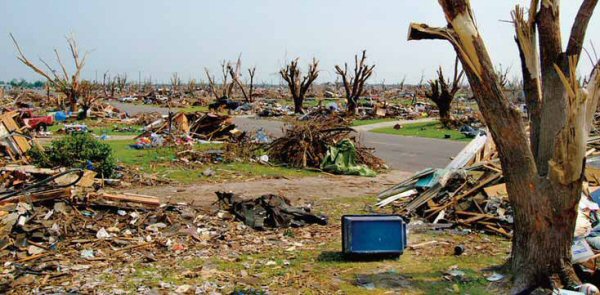SEJournal Online is the digital news magazine of the Society of Environmental Journalists. Learn more about SEJournal Online, including submission, subscription and advertising information.

E-Reporting Biz
By BUD WARD
Will It Reap a Rethinking?
How many puzzle pieces, I wonder, would it take to assemble a reasonable image of all that has happened over the past year or so to help shape our nation’s energy future? And our public’s understanding of, and concern for, it, or their lack of same?
Surely those puzzle pieces would need margins of error to allow for the inevitable uncertainties. They had better be three dimensional, too. And they need to be chain-like, in that any missing link or misplaced piece would topple the whole thing and send it reeling.
It seems somehow trite — beguilingly charming, even — to recall how just recently so many in both the journalism and science communities viewed our warming Earth as “the story” of the century.
But now? Words like “climate change” or “global warming,” let alone the name Al Gore, barely pass the public lips of policymakers in Washington’s highest circles. The subject of climate change, it seems, is clearly verboten.
Yet a sentient society — with an ever-watchful and responsible media — should be well beyond asking just what’s going on by now. Something a little more meaty than just “Wassup?” Instead, its voice keeps getting drowned out in the popular media by the likes of Royal Wedding déjà vus and ladies’ hats, Paris Hilton’s arrests and near-arrests, Charlie Sheen’s antics, drummed-up presidential birth certificate brouhahas, and — oh yes — really worthwhile news like the successful taking down of Osama Bin Laden, the continuing housing crisis, and the weighty issues and politics surrounding the nation’s debt ceiling.
 |
|
Virtually all the trees in the path of the killer tornado that devastated Joplin, MO, were completely defoliated. Photo:
 by Kevin J. Hunt Via Flickr. by Kevin J. Hunt Via Flickr. |
Please consider:
ITEM: It’s just more than a year now that the BP Deepwater Horizon (not, by the way, the term BP spinmeisters prefer it be named) plunged Louisiana and much of the Gulf of Mexico into what can at best be years or decades of uncertainty over the long-range impacts of what many legitimately consider our nation’s worst environmental disaster.
With haunting undersea live images of incessantly leaking oil and a real-time widget tracking what at the time passed as best guesses of total volumes spilled, the tragedy brought a sudden halt to the Obama administration’s just-announced plans for expanding offshore drilling. The oiled seabirds and marine life and gooey marshes cast a new light on the endless downsides of the nation’s fossil fuel “addiction,” as then-President George W. Bush rightly and famously labeled it. And it even appeared to give new life to expanded plans for domestic nuclear power, and, get this, perhaps,to a new push for renewables.
That it did all of those things with nary a public reference —save but from the most true-believers — about the relevance of climate change still befuddles many who see it, at the very least, as an educational opportunity missed. Lest one forget, we’ll need individual and varying puzzle pieces and sizes representing events, big and small ... and this is by no means a comprehensive listing.
ITEM: “Lions, and tigers, and bears, oh my!” goes the engrained jingle from “The Wizard of Oz.”
But we’re not just in Kansas any more,and the past months could give rise to “Fires, and flooding, and tornadoes, oh my!” in summing up the weird weather tormenting much of the U.S. mainland and the world in general.
Keep in mind:
- Widespread and terrifying wildfires haunted extensive western Texas acreage in April, sending strong smoke odors as far east as Dallas and Fort Worth. And, come May, killer tornadoes ripped through Oklahoma and Missouri and claimed deaths in North Carolina and — for the first time in about two decades — caused deaths also in tidewater Virginia. The giant storm that destroyed one-third of Joplin, Mo., killing at least 140 people there, has made 2011 the most deadly year on record for tornadoes. As of May’s close, 520 had died in twisters.
- Global surface temperatures for 2010 tied 2005 as the warmest in 131 years of recordkeeping. As NOAA explains it, that 2010 record is especially surprising given that “the last half of the year was marked by a transition to strong La Niña conditions” generally associated with a cooling of Pacific Ocean surface temperatures. And this despite the often record-setting cumulative snowfalls that earlier last year had rocked major mid-Atlantic and northeastern population centers.
- The so-called “Middle East Spring” began in Tunisia and has since spread through Egypt, Syria, and Libya, surely contributing to the speculator-fueled higher gas prices at the pump so loathed by the American public and its vote-hungry politicians.
- On a more microlevel, thousands of visitors to the annual meeting of the American Association for the Advancement of Science (AAAS) in February 2011 weathered balmy, spring-like conditions one day and winter chills the next. More notably, 40-mph winds and the suburban wildfires — this is Washington, D.C., mind you, and not annually parched Florida or Santa Ana-winds-blown California — closed Interstate 95 both north and south of the city’s iconic I-495 Beltway. Whooda thunk it?
- The double whammy of a calamitous at-sea earthquake and a treacherous tsunami in Japan result in one of the world’s most serious nuclear power plant failures. Thousands of lives lost and thousands more missing tell only the most serious impacts from a tragedy striking one of the world’s most sophisticated and technologically advanced countries. And, of course, there are long-term impacts for (make that against) nuclear power worldwide.
- The 500-year Mississippi and Yazoo Rivers cresting at or near record-high flood stages and immersing parts of Memphis, Mississippi, and Louisiana have prompted rare openings of Mississippi River spillways to spare Baton Rouge and New Orleans at the expense of thousands of acres of farm land and presumably less “important” places like Morgan City.
 |
|
An Air Force C-130 Hercules from Colorado Springs, specially equipped to deliver fire retardant, drops a load in late April on a fire in West Texas, where over 1,000 square miles had already burned. U.S. Air Force Photo by Staff Sgt. Eric Harris.
|
This long list of calamitous climate events can’t help but prompt some to wonder about a sentient population. Where is it? And what about that robust infrastructure of ever-watchful news media?
For now, the prospects for more “anomalous” weather appear more likely than the full-throated return of that watchful media and attentive and sentient public. But on that point, let’s hope we’re wrong.
Bud Ward is an independent journalism educator and founder/former editor of Environment Writer. He now is editor of The Yale Forum on Climate Change & the Media.
* From the quarterly newsletter SEJournal, Summer 2011 issue.












 Advertisement
Advertisement 




